|
Down to the Sea in Ships
by Bob
Brooke
As
maritime museums go, Mystic Seaport is one of the best. Unlike
Williamsburg which recreates 18th-century city life, Mystic Seaport
isn’t a recreation but an actual seaside village assembled mostly from
vintage buildings from all over New England on the grounds of a working
shipyard from the 19th century. Here, staff members—historians,
storytellers, craftspeople, and musicians—bring the 19th century
seafaring village to life.
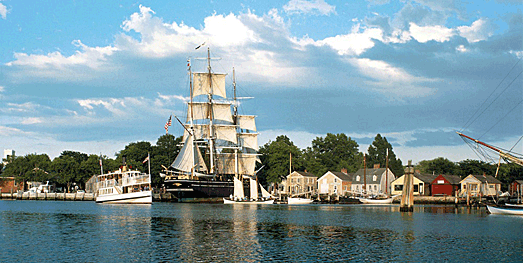
From the new main entrance exhibit building, you can take a leisurely
walk along the quayside, stopping at buildings representing a number of
different services needed by 19th-century seamen, as well as
19th-century homes.

Whaling Front and Center
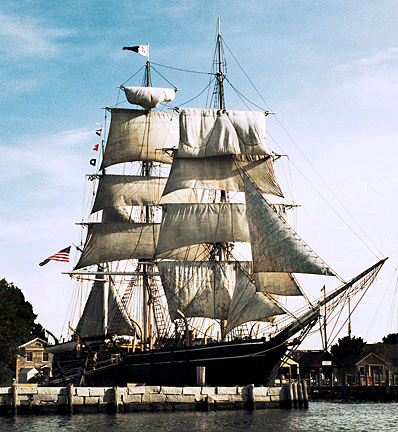 The
centerpiece of Mystic Seaport is the whaleship Charles W. Morgan which
lies at anchor at Chubb’s Wharf, modeled after the granite wharves where
it originally docked in New Bedford, Massachusetts, one of New England’s
premier whaling seaports. The
centerpiece of Mystic Seaport is the whaleship Charles W. Morgan which
lies at anchor at Chubb’s Wharf, modeled after the granite wharves where
it originally docked in New Bedford, Massachusetts, one of New England’s
premier whaling seaports.
In the center of the wharf is a representation of an oil pen, where
casks of whale oil would have been stored before processing. At the end
of Chubb’s Wharf is a shed that houses the Museum’s Whaleboat Exhibit.
Here, you’ll find a fully equipped whaleboat. The Museum built this
structure, patterned after those on New Bedford's whaling wharves, in
1982. The whaleboat originally came to Mystic aboard the Charles W.
Morgan in 1941. In it lay examples of the gear typically carried in
American whaleboats of the 1880s. Notice the whaling tools displayed
above the boat.
The Charles W. Morgan is the last of an American whaling fleet that
numbered more than 2,700 vessels. Built and launched in 1841, the Morgan
is now America’s oldest commercial ship still afloat—only the USS
Constitution is older. Launched on July 21, 1841 from the yard of Jethro
and Zachariah Hillman in New Bedford, Massachusetts, she typically
sailed with a crew of about 35. The huge try-pots used for converting
blubber into whale oil sit forward. Down below are the cramped quarters
in which her officers and men lived. Over an 80-year whaling career, the
Morgan embarked on 37 voyages with most lasting three years or more.
Built for durability, not speed, she roamed every corner of the globe in
her pursuit of whales. She arrived at Mystic in November 1941. She has
been lovingly restored to full sailing condition.
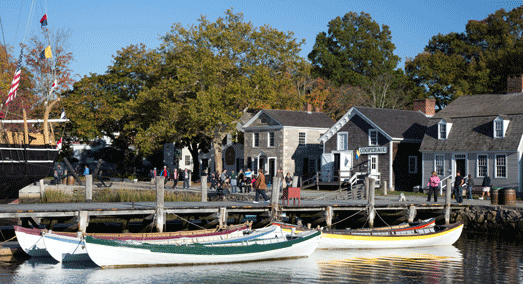
A row of marine trades shops and commercial buildings lines the
quayside. Across from the whaleship Morgan stands the Mystic Bank, with
the office of shipping merchant Thompson and Mason housed on the second
floor. In the larger seaports, some merchants specialized in operating
ships. They owned or chartered the vessels they operated, which either
ran on a regular route between ports or else “tramped” around the
oceans, carrying whatever cargo was available to wherever it had to go.
Sometimes they purchased cargoes to ship, hoping to make a profit on
their sale in another port. Otherwise, they sold space in their ships
and collected freight money from the shippers based on the weight or
volume of each owner’s part of the cargo. As immigration increased, some
merchants specialized in shipping passengers.
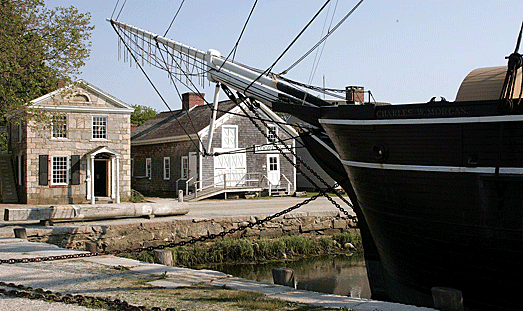
Serving Ship Owners, Captains, and
Sailors
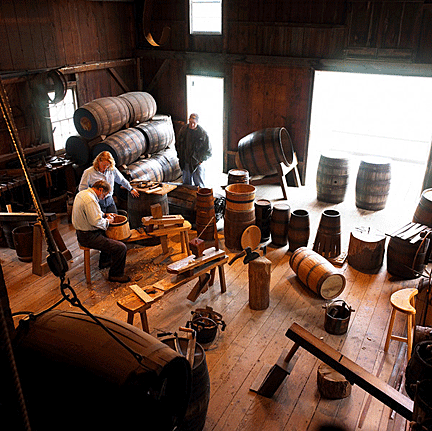 Next
to the Bank stands the cooperage, a shop where round wooden containers,
now called barrels, were made. These were an essential article of life
both at sea and ashore. Wooden containers made from staves and hoops
served many storage purposes. Aboard ship they held provisions, various
kinds of cargo and, on certain fishing and whaling vessels, the catch.
The shop contains a hearth large enough to work in, a crane with a block
and tackle and chine hooks, and a loft for storage. You can learn how to
make barrels here. Next
to the Bank stands the cooperage, a shop where round wooden containers,
now called barrels, were made. These were an essential article of life
both at sea and ashore. Wooden containers made from staves and hoops
served many storage purposes. Aboard ship they held provisions, various
kinds of cargo and, on certain fishing and whaling vessels, the catch.
The shop contains a hearth large enough to work in, a crane with a block
and tackle and chine hooks, and a loft for storage. You can learn how to
make barrels here.
A few
doors up stands the shop of a 19th-century printer. Working at typecase
and press, he was a vital force in the economic, intellectual, and
spiritual development of New England’s seacoast communities.
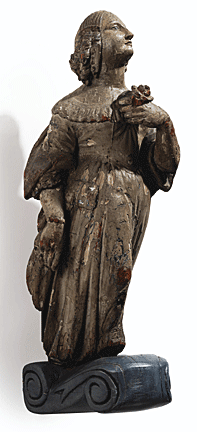 The
Mystic Press, assembled to represent a newspaper and job printing shop
of the time, contains the tools and technology of the journeyman
printer’s trade. From shops like this, with their Wells and Washington
presses, platen job presses, and Cranston cylinder press, came the
almanacs, the newspapers, the books, and the handbills so important to
the business, political, and social life of the community. The
Mystic Press, assembled to represent a newspaper and job printing shop
of the time, contains the tools and technology of the journeyman
printer’s trade. From shops like this, with their Wells and Washington
presses, platen job presses, and Cranston cylinder press, came the
almanacs, the newspapers, the books, and the handbills so important to
the business, political, and social life of the community.
The rear of that same building houses the shipcarver’s shop. Figureheads
and other carvings which decorated wooden ships in the Age of Sail are
sometimes all that remain from the many vessels built in the 19th
century. Carvings on a vessel were meant to show pride and to capture
the public’s attention. Commercial vessels were required to have a name
and the carvings frequently reflected that name. Choosing a name that a
shipping customer would remember, and having a figurehead that
reinforced that memory, was important to ship owners.The Mystic Seaport
Ship Carver exhibit is meant to portray the shop of such an independent
tradesman, and the staff who work in the exhibit carve nameboards,
trailboards, figureheads, and sternboards for boats, as well as shop
signs, tobacconists’ figures, and decorations meant for the home.
Next door to the printer’s shop is the hoopmaker’s shop. The hoop maker
specialized in the manufacture of wooden mast hoops of assorted sizes
which held the sail to the mast on fore-and-aft rigged vessels. Hoop
making reached its peak as the fore-and-aft sailing rig proliferated in
the mid-19th century, and flourished until World War II. Relatively few
men practiced this craft even then, and consequently, exhibits such as
this are rare.
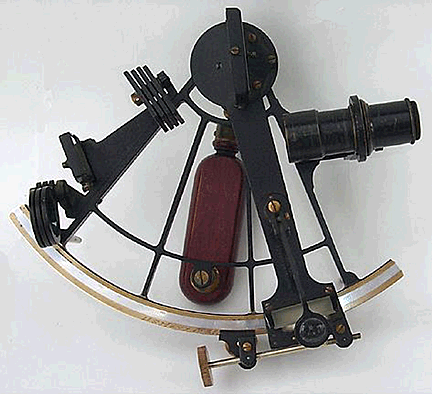 And
next to the hoopmaker’s shop stands the nautical instrument shop. Here
the ships’ officers could purchase or have adjustments made to their
precise and somewhat delicate navigational tools. To find their way at
sea far from the sight of land, captains depended upon their quadrants
and sextants, which they used to measure the angle between the horizon
and a star or sun, as well as their marine chronometer and nautical
charts and tables to determine their exact location on the watery world. And
next to the hoopmaker’s shop stands the nautical instrument shop. Here
the ships’ officers could purchase or have adjustments made to their
precise and somewhat delicate navigational tools. To find their way at
sea far from the sight of land, captains depended upon their quadrants
and sextants, which they used to measure the angle between the horizon
and a star or sun, as well as their marine chronometer and nautical
charts and tables to determine their exact location on the watery world.
The shipsmith shop stands next to the nautical instrument shop, built at
the head of Merrill’s Wharf in New Bedford by James D. Driggs in 1885.
He, along with his partner, Joseph Dean, produced a variety of whaling
tools—harpoons, cutting irons, ship’s fittings, etc. The Museum brought
the shop to Mystic seaport in 1944 to compliment the whaleship Morgan.
It’s the only maker of ironwork for the whaling industry that has
survived.
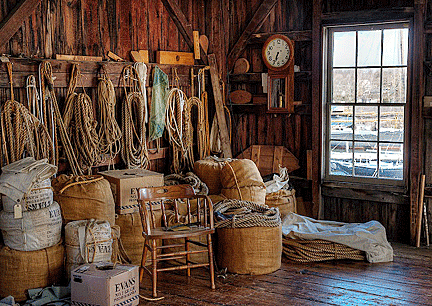 Down
at the end of the quayside stands the chandlery and sailmaker’s loft.
Individual seamen as well as ships could obtain supplies from the ship
chandlery. The chandler was a specialist in meeting the needs of his
community, whether they were for whaling, shipping, fishing, or ship
building. A ship’s agent was responsible for contracting for provisions
at the chandlery. He managed supplies and equipment, as well as repairs,
freight, towage, and the hiring of officers and crew. Chandlers offered
salt fish and meat, hardtack, molasses, potatoes, onions and other
winter vegetables, spices, and flour. Rum and tobacco were also in
stock. Clothing, boots, and blankets were purchased for sailors who
often bought them while at sea, and supplies for the ship itself ranged
from navigational instruments to lanterns, buoys, logs, and inkstands.
Needles, beeswax, and canvas were available for use in repairs aboard
ship as well as for the sail maker at home. In addition, marine
hardware, paints, oils, and compounds were available. Down
at the end of the quayside stands the chandlery and sailmaker’s loft.
Individual seamen as well as ships could obtain supplies from the ship
chandlery. The chandler was a specialist in meeting the needs of his
community, whether they were for whaling, shipping, fishing, or ship
building. A ship’s agent was responsible for contracting for provisions
at the chandlery. He managed supplies and equipment, as well as repairs,
freight, towage, and the hiring of officers and crew. Chandlers offered
salt fish and meat, hardtack, molasses, potatoes, onions and other
winter vegetables, spices, and flour. Rum and tobacco were also in
stock. Clothing, boots, and blankets were purchased for sailors who
often bought them while at sea, and supplies for the ship itself ranged
from navigational instruments to lanterns, buoys, logs, and inkstands.
Needles, beeswax, and canvas were available for use in repairs aboard
ship as well as for the sail maker at home. In addition, marine
hardware, paints, oils, and compounds were available.
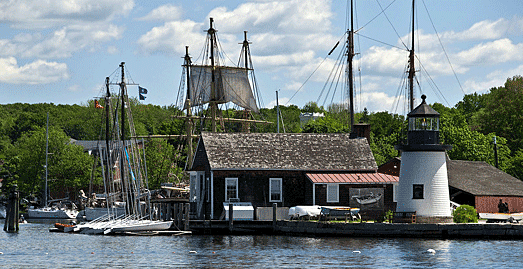
Charles Mallory operated the sailmaker’s loft above the chandlery.
Mallory came to Mystic in 1816. He prospered as whaling and shipbuilding
grew in the village and by the 1860s was one of Connecticut’s most
prosperous ship owners. Beginning in the 1870s, ships’ designers
supplied blueprints of the sail area to the chandler. Prior to that
time, sailmakers made their own patterns. After measuring the masts and
yards of the ship, the sailmaker made a paper pattern to scale, and then
sketched in the outline on the floor of the loft. In order to have as
much uninterrupted working space as possible, even the stove was
suspended from the ceiling rather than have it sit on the floor.
After the canvas was cut to the pattern on the floor, it was sewn
together and bolt rope was stitched on the edges. The chandler then
added fittings for attaching the sail to the yard or mast. Helpers used
a machine to stitch the pieces of cloth together but adding the bolt
rope and fittings had to be done by hand. This sail loft was originally
located downriver, but it was brought here by barge in 1951.
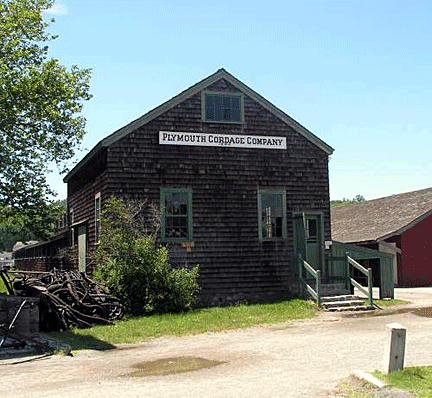 In
a long low wooden building next to the chandlery is a 250-foot segment
of the Plymouth Cordage Company’s ropewalk, built in 1824. The original
building, located in Plymouth, Massachusetts, was more than 1,000 feet
long and contained three rope-making grounds. It was impossible for a
sailing vessel to operate without rope, so this was of prime importance.
Early on, ropemakers used hemp, but by the 1830s a fiber called manila,
imported from the Philippines, became their preferred material. Here you
can see a ropemaking demonstration on most days. In
a long low wooden building next to the chandlery is a 250-foot segment
of the Plymouth Cordage Company’s ropewalk, built in 1824. The original
building, located in Plymouth, Massachusetts, was more than 1,000 feet
long and contained three rope-making grounds. It was impossible for a
sailing vessel to operate without rope, so this was of prime importance.
Early on, ropemakers used hemp, but by the 1830s a fiber called manila,
imported from the Philippines, became their preferred material. Here you
can see a ropemaking demonstration on most days.
The fully rigged Danish naval training ship, Joseph Conrad, one of 16
historic vessels at Mystic Seaport, lies at anchor along the quayside
just beyond the ropewalk. Built in 1882, she had an illustrious career
with the Danish Navy before being retired and privately owned. She came
to the Seaport in 1945. Beyond the ship at the end of the quayside
stands a replica of the Brant Point Lighthouse. On the other side of the
spit of land that juts into the Connecticut River are several seafood
shacks.
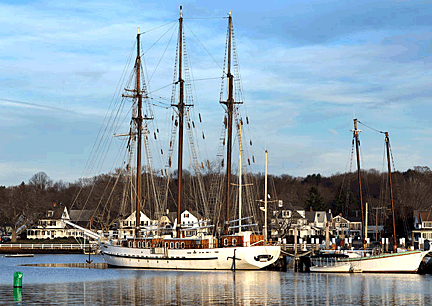
Fishing was a big part of the local economy in the 19th century. Here
you’ll find the salmon and lobster shacks, where lobsterman prepared
their traps and salmon fishermen sorted their catches, and the oyster
house which came from New Haven, once the largest oyster distribution
center in New England.
Saving Sailors’ Lives
During the 19th century, few sailors knew how to swim and shipwrecks
were numerous.
Across from the lobster shack stands the New Shoreham Lifesaving
Station, built in 1874, and one of the last survivors of the Atlantic
seaboard stations built to government
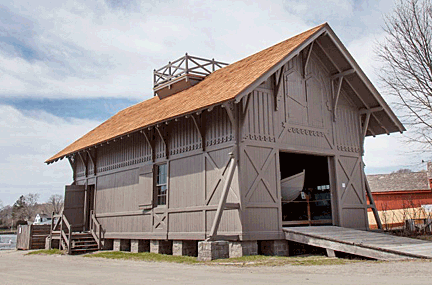 specifications
from Maine to Florida. The building faces inland, as it did in Old
Harbor, so that the large doors are accessible to the town roads when
moving the surfboat or beach cart. The boatroom has original gear for
the two most common methods of rescue: the breeches buoy (see below) and
the surfboat. The messroom has representative equipment used by the
seven men who manned this station eight months a year. The upstairs area
contained the sleep and storage rooms but will not be set up as an
exhibit because of access considerations. It was in use for about 16
years in Old Harbor on Block Island, Rhode Island. In July 1968, it was
brought to Mystic Seaport by barge in exchange for a reproduction. specifications
from Maine to Florida. The building faces inland, as it did in Old
Harbor, so that the large doors are accessible to the town roads when
moving the surfboat or beach cart. The boatroom has original gear for
the two most common methods of rescue: the breeches buoy (see below) and
the surfboat. The messroom has representative equipment used by the
seven men who manned this station eight months a year. The upstairs area
contained the sleep and storage rooms but will not be set up as an
exhibit because of access considerations. It was in use for about 16
years in Old Harbor on Block Island, Rhode Island. In July 1968, it was
brought to Mystic Seaport by barge in exchange for a reproduction.
Beyond the Lifesaving Station on the back side of small peninsula are
some 19th century homes, a chapel, general store, drugstore and doctor’s
office, a schoolhouse, and the Seamen’s Friend Society Reading Room.
Learn more by reading “Long
Ago is Not Far Away at Mystic Seaport."
<
Back to More Antiques to View
Next Article > |
